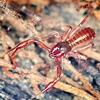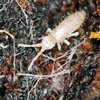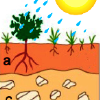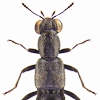 In the article Evolution of springtails , I point out that springtails have managed to survive through geological eras, unlike other animal species that have suffered mass extinctions. These extinctions can be linked to biological changes in the environment such as episodes of plant proliferation...
In the article Evolution of springtails , I point out that springtails have managed to survive through geological eras, unlike other animal species that have suffered mass extinctions. These extinctions can be linked to biological changes in the environment such as episodes of plant proliferation...
Biotope of springtails
The challenges of survival
Microfauna and cohabitation with springtails
 In the article Elements of taxonomy we note, within the animal kingdom, a phylum called Arthropods (from the Greek arthron (articulations) and podos (feet"). These invertebrates themselves have four sub-branches in which Crustaceans, Arachnids, Hexapods
In the article Elements of taxonomy we note, within the animal kingdom, a phylum called Arthropods (from the Greek arthron (articulations) and podos (feet"). These invertebrates themselves have four sub-branches in which Crustaceans, Arachnids, Hexapods
Potential agricultural auxiliary ?

This article is based on a study , published in March 2023, which aims to analyze food preferences and the impact of the consumption of springtail Heteromurus nitidus (below) on fungal populations, particularly belonging to phytopathogenic species...
Organic decomposition
 Have we ever wondered what our forests and grasslands would be like if the leaves that fall every autumn remain on the ground as they are? An important role of springtails is their contribution to the ecological balance of the soil microfauna, which allows the dissemination and regulation
Have we ever wondered what our forests and grasslands would be like if the leaves that fall every autumn remain on the ground as they are? An important role of springtails is their contribution to the ecological balance of the soil microfauna, which allows the dissemination and regulation
Soils and their biodiversity
 By observing the ground, we see some of the fauna that inhabits it evolving. But the majority of organisms and the mechanisms that make it live remain hidden from view and are only revealed on dimensional or temporal scales that escape our perception. soils , on which we depend much more than one might imagine at first glance, are little known, both in their physical constitution and in the interactions of all kinds that take place there...
By observing the ground, we see some of the fauna that inhabits it evolving. But the majority of organisms and the mechanisms that make it live remain hidden from view and are only revealed on dimensional or temporal scales that escape our perception. soils , on which we depend much more than one might imagine at first glance, are little known, both in their physical constitution and in the interactions of all kinds that take place there...
Soils formation
 It seemed to me useful to write an article to briefly discuss how soils evolve from the stage of the source rock. This process is the same since the origins of the Earth. Without him, life might not exist in the forms we know today. The sketch below1 summarizes the formation of soils in four
It seemed to me useful to write an article to briefly discuss how soils evolve from the stage of the source rock. This process is the same since the origins of the Earth. Without him, life might not exist in the forms we know today. The sketch below1 summarizes the formation of soils in four
The spearing of springtails by a beetle, an unprecedented mode of predation
 While some predatory insects hunt "on the run" or in flight, others adopt a motionless position and capture their prey from a distance with their front legs or their modified mouthparts. This is the case for mantises, mantis religiosa or certain bugs...
While some predatory insects hunt "on the run" or in flight, others adopt a motionless position and capture their prey from a distance with their front legs or their modified mouthparts. This is the case for mantises, mantis religiosa or certain bugs...
Springtails bioindicators
 For a long time the study of the soils was reduced essentially to chemical analyzes, in order to detect the presence and the concentration of various chemical compounds. But the results obtained did not tell us anything about their interaction between these substances and the organisms
For a long time the study of the soils was reduced essentially to chemical analyzes, in order to detect the presence and the concentration of various chemical compounds. But the results obtained did not tell us anything about their interaction between these substances and the organisms
Springtails are everywhere

Alarming finding
 Crossing the geological eras, some species of springtails current are similar to Oligocene fossils (-30 Ma) tending to show that they are rather "finished". With regard to the appearance of homo erectus (-1.8 Ma) or that of our own species, homo sapiens (-100 000 years) and given our way of
Crossing the geological eras, some species of springtails current are similar to Oligocene fossils (-30 Ma) tending to show that they are rather "finished". With regard to the appearance of homo erectus (-1.8 Ma) or that of our own species, homo sapiens (-100 000 years) and given our way of